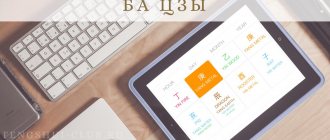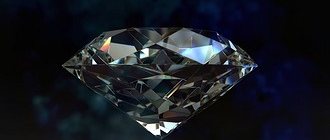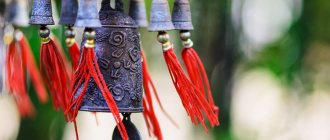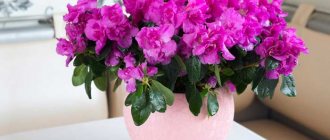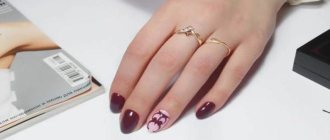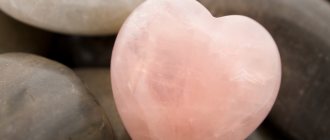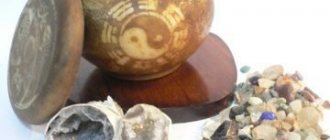What to read about Feng Shui?
My library of feng shui books occupies an entire closet; I began collecting it in the 1990s, when the first Russian publications by Richard Webster and Sarah Rossbach began to appear. But only a few of these books are really worth reading for beginners! I am publishing here a list of books on Feng Shui, with which you can start studying this science, or, more precisely, getting acquainted with it, since it is difficult to become a specialist after reading even 20 books.
In order to find out what Feng Shui is and understand the basic principles of this science, start with a book, for example, by the famous Master Raymond Lo
1. “The Golden Rules of Feng Shui” (Astrel, 2009). This book, of course, has technical errors, but Master Ro talks about the basic theories of Feng Shui quite comprehensively.
You can also read Lillian Too . But DO NOT buy ALL her books. Find the first three:
2. “Fundamentals of Feng Shui” (1998 by Lillian Too), published for the first time in 2000, Sofia Publishing House, republished in 2008
3. “Feng Shui and Abundance” (1999 by Lillian Too), appeared in 2000, republished in 2006
4. “Feng Shui using Bagua and Lo Shu formulas” (1993 by Lillian Too), published in Russian in 2002. As far as I know, it has not been reprinted.
In these books, Lillian Tu still adhered to the texts of the ideas that Grand Master Yap Chen Hai, her Teacher, told her. It is in these works that a combination of Lillian’s talent for popularization and information about classical feng shui is observed.
Unfortunately, almost all of her subsequent books are rehashes of the same thing, with an ever-increasing number of pictures and recommended characters. I don’t argue that this helps her sell souvenirs and make good money, but it reduces the informational value of the books. In addition, Lillian became interested in the Blackcap school and also began to divide everything into zones - wealth, fame, etc. (more on this in another post).
Next (or maybe you’ll start with these), it’s worth reading two books from the “Step by Step” series:
5. “Feng Shui”, Elizabeth Moran, Master Joseph Yu, Valery Biktashev . (2002) was published in Russia in 2005. It is successful in its structured and consistent presentation and is written in fairly simple language. Be careful, the theory of flying stars is presented very superficially!
6. “Feng Shui in Russian”, Anatoly Sokolov . (2006). The book is notable for the fact that the author sets out the basic principles of Feng Shui, accompanied by a large number of questions and answers on each topic. In principle, if everyone who is interested reads it, half of the questions on the Feng Shui Forum will disappear by themselves.
(2006). The book is notable for the fact that the author sets out the basic principles of Feng Shui, accompanied by a large number of questions and answers on each topic. In principle, if everyone who is interested reads it, half of the questions on the Feng Shui Forum will disappear by themselves.
7. Many people recommend the “Feng Shui Textbook” by Lev Igelnik, but I DO NOT recommend it; such a “textbook” can only confuse beginners. The 2 volumes of the book contain so many different theories, both working and dubious, that it resembles a salad of poorly combined products.
If you have progressed so far that you have decided to study the theory of Flying Stars, try to find the book
8. “Feng Shui Lucky Star. Theory and practice." , Stephen Skinner (2003). It has also not been reprinted since then.
Or a book
9. Anatoly Sokolov “The House Where Wealth and Love Live” (Astrel, 2010)
Both books will give you some idea of the theory of flying stars, but will not make you a practitioner, since some topics important for understanding stars are not covered there.
I would not recommend starting with Lillian Tu's books about flying stars, because there is already a lot of pop feng shui in these books.
If you take on Eva Wang , keep in mind that many beginners find her quite difficult. In addition, Eve Wong's Flying Stars Feng Shui differs from the more common approaches in Russia in many nuances. Don't get confused!
10. On Flying Stars, a book by Lev Igelnik “Feng Shui of Flying Stars” was recently published, Sofia, 2008. As usual, the author is consistent in his presentation. It is told about the technique, about the Masters whose books were published on this issue in Russia, about the nuances of application. There is one small but: the book, in my opinion, is most useful to read for those who have already practiced this technique a little, since the opinions of different consultants are given, which often do not coincide with each other, which greatly confuses beginners. At the first stage of learning, you should start with the classics; innovative approaches will be interesting to you when you have already accumulated your own experience. 11. You can also purchase the book “A Handbook for Practitioners” by Vincent Koch. It will be useful for those who have already studied something, since there is not enough information in it to read. Be careful - there are technical errors in the book!
Finally, I would like to say that Natalia Pravdina’s books, beloved by many, do NOT belong to classical feng shui. This is an excellent example of simple books on positive thinking, imaginative, spiritual, but you should not start getting acquainted with Feng Shui from them. In principle, when you open any book and see a description of the zones of wealth, marriage, career, and so on, you can safely close it and put it on the shelf. Of course, this is only if you really decide to study Feng Shui. Stones, plants, figurines, treasure maps and house cleansing also do NOT belong to Feng Shui.
This is an excellent example of simple books on positive thinking, imaginative, spiritual, but you should not start getting acquainted with Feng Shui from them. In principle, when you open any book and see a description of the zones of wealth, marriage, career, and so on, you can safely close it and put it on the shelf. Of course, this is only if you really decide to study Feng Shui. Stones, plants, figurines, treasure maps and house cleansing also do NOT belong to Feng Shui.
I would also NOT advise buying feng shui encyclopedias, books by Russian and foreign authors unknown in their practical activities, as well as books that promise you feng shui in 5 days or 5 minutes) Most of these books are shameless compilations, poor translations from English or simply freestyle essays on the topic. A Chinese surname on the cover also does not guarantee you the correct information inside. And, again, books are just the beginning. who wants to become a specialist in the field of Feng Shui, because firstly, none of them will give you deep knowledge, and secondly, only a Master or a teacher-consultant who himself studied with the masters and checked the nuances can teach you the practical application of Feng Shui application in practice.
Happy reading,
Natalya Tsyganova
Books on Feng Shui
Feng Shui is an art that originated in the Ancient East and is actively practiced in our time. It talks about how you can change the environment around a person and his inner world in order to influence health, luck, prosperity, family happiness, career and other aspects of human existence.
Feng Shui - this word consists of two Chinese characters - “wind” and “water”, from which it follows that this is the doctrine of wind (air) and water as two natural phenomena that are life-forming elements, fundamental forms of Qi energy.
The history of Feng Shui goes back several thousand years. The Chinese knew and practiced this art about 5,000 years ago, and the fact that it is not forgotten today can be considered proof of its practical usefulness and positive results from its use.
At a time when there was no unified Chinese state, most people built their homes in the floodplain lands between the Yangtze and Yellow Rivers. Among these ancient Chinese, special honor was given to people who observed the forces of nature and used their skills to benefit the tribe. Such people were called shamans.
The shaman rulers of Ancient China were endowed with the ability to control the elements of wind and water. Early historical documents, in which fiction is closely intertwined with real facts, mention the ability of shamans to carry out the transformation of elements themselves. The first such ruler was Fu Xi. Together with his successors Shen Nun and Huang Di, he taught people many arts and crafts. It is Fu Xi who is considered the founder of the Chinese science of fortune telling. According to legend, a mythical animal appeared to him from the waters of the Yellow River, on whose back he saw a pattern consisting of dots and circles. This pattern later formed the basis of the pre-heavenly Ba-Gua, or early celestial sequence (Circle of the Former Heavens).
During the reign of Huang Di, who was called the Yellow Emperor, the first lunar calendar was compiled. Under Huang Di and his successors - Zhuang Xue, Ku Yao and Shun - the “golden age” continued in China: the people respected the emperors, whose rule was perfect.
The founder of the first Chinese Xia dynasty (presumably 2205-1766 BC) was an emperor named Yu. He ascended the throne at a time of difficult trials for the Chinese people: for more than twenty years, with short interruptions, people suffered from the consequences of severe floods that completely devastated the eastern regions of the country. Yuya's father tried to fight the water elements by building dams. However, his attempts were unsuccessful: the water overflowed more and more, flooding more and more lands. After becoming emperor, Yu decided to fight the disaster in a different way. He ordered that canals begin to be dug so that water would drain away from the flooded areas. The scale of this project was impressive: four mountains in China were erected from the earth dug out during the construction of canals!
After pacifying the water element, a huge turtle rose from the waters of the river, on whose shell a magical pattern consisting of nine symbols (Lo-Shu) was inscribed. That is why the Chinese lands were subsequently divided into nine regions (divisions), and the pre-heavenly Ba-Gua, reflecting the unchanging nature of things, was replaced by the post-heavenly Ba-Gua (Circle of Subsequent Heavens), which was used to predict the changeable manifestations of the laws of existence.
During the reign of the first emperor of the Zhou dynasty (1122-770 BC), Wu Wang, another significant event occurred related to the Feng Shui number. The ruler's mentor was the minister Jiang Taigong, who mastered the secrets of magic and the ability to predict the future. It is he who is credited with the creation of sixty-four hexagrams based on the eight trigrams of Ba-Gua. The interpretation of these hexagrams formed the basis of the I Ching - the Book of Changes.
Wu Wang's descendant, Emperor Shin, improved the Lo Pan geomantic compass, combining knowledge about it with elements of the I Ching fortune-telling system. As a result, the Luo Jing system appeared (it has not survived to this day). With the help of this system and the Ba-Gua symbol, the most favorable places for the construction of palaces and burial of the dead were determined. The ancient Chinese attached great importance to the search for a successful burial place, since it was believed that if this place was favorable, then luck would accompany the seven subsequent generations.
Chinese rulers studied not only the landscape and the invisible energies that permeate the air, water and land. They also observed the celestial bodies, compiling star charts and calendar systems. In the Bronze Age, during the Shang Dynasty, a sixty-day (lunar) cycle was established, and the movement of the constellations was ordered into two systems: twelve Earthly Branches and ten Heavenly Stems. Each day was marked by the combination of one Branch and one Trunk in a sequential order. Later, the sixty-day cycle was compared with the astronomical (solar) year: 365 (6) days were divided into six cycles.
During the Zhou Dynasty, correspondences were also established between the ten Heavenly Stems and the five elements (elements): Water, Wood, Fire, Earth and Metal, and the twelve Earthly Branches began to be considered as twelve astronomical months. During the period from the 6th to 5th centuries BC, when Lao Tzu and Confucius lived, the Earthly Branches were correlated with animal symbols that are used in the Chinese calendar today.
The date of origin of the teachings of Feng Shui is the time when the first written rules of this philosophy appeared. The principles of Feng Shui and methods of their practical application were described in the ancient texts “Shi Jing” (“Book of Songs”) and “Li Tzu” (“Book of Rituals”). It talked about the methods in the book of Feng Shui for finding favorable places for family burials and burial mounds.
After simplifying and systematizing the rules of written language, five canonical ancient Chinese texts (one of them was the I Ching) were edited and translated into a new form of writing. Also, various oral versions and traditions about the use of oracle predictions were collected and recorded by imperial scholars. Thus the “Ten Wings” appeared, which were attached to the main text.
The three main elements used for fortune telling and determining favorable life situations - the geomantic compass Lo Pan, the I Ching and the lunar calendar - were combined into a scientific and mystical teaching practiced by fanshi (“experts in teaching”). During the reign of the Han Dynasty and the Three Kingdoms (221-265 AD), this teaching practically merged with the theories of the Taoist sects, and its followers began to enjoy great influence at the imperial court and among the people. Deep knowledge in the fields of astronomy, geography, medicine and practical magic made fanshis respected and revered. They were always welcome guests both in the palaces of aristocrats and in modest rural dwellings.
The basis of fanshi philosophy was the doctrine of Yin-Yang energies and the five elements (Water, Wood, Fire, Earth and Metal). The theory and practice of fortune telling using the I Ching were supplemented by a complex system of astrological calculations, geomantic measurements and knowledge obtained from observations of earthly and celestial phenomena.
During the Han Dynasty, the theory of Feng Shui began to acquire the features of a professional activity, but at that time it was known as Kan-Yu (“kan” - “earth”, “yu” - “pattern”, “sample”). Mentions of it are contained in the Huainan Zi, a kind of encyclopedia of Taoist knowledge, which was compiled in the 1st century BC. Based on the recommendations of Feng Shui masters, all houses and imperial palaces were built, and the location of the imperial throne was chosen. Even cities were built in areas favorable from the point of view of this philosophy (this is how, for example, Hanoi and Beijing arose).
By the end of the Han Dynasty, the Chinese state had split into three separate kingdoms, which were constantly at war with each other. The minister of the kingdom of Shu, the Taoist magician Zhuge-Liang, who has the ability to control winds and fogs, developed the Qimen-Dongjia system (“mysterious entrances” - “secret movement”). This system was originally designed to allow troops to move undetected using the earth's "secret gates" that opened and closed only at certain times of the year. Taoist magicians knew where such gates were and knew how to use them. In the Qimen-Dongja system, a combination of Ba-Gua symbols and the Lo-Shu magic square was used to determine favorable and unfavorable areas of the landscape. Subsequently, this system had a significant impact on the development of Feng Shui theory.
After the Chinese lands were once again united under the rule of the Jin Dynasty (265-316 AD), a man appeared who is considered by modern Feng Shui masters to be the “father of geomancy.” His name was Guo Pu, he was a scientist, a poet, and also a recognized master in choosing favorable places for burials. Both emperors and ordinary people used his services. Guo Pu left behind several treatises that described the rules for choosing burial sites and made a classification of landscapes. Historical records indicate that these works were very popular and subsequently became classics.
The three-century reign of the Tang Dynasty (618-907 AD) is considered the heyday of Chinese arts and sciences. New trends and schools appeared in Kan-Yu philosophy. Some masters used the forms of natural landscapes for geomantic fortune-telling, others were based on the connection between the position and directions of movement of celestial bodies, and some used the Ba-Gua trigrams to determine the energy structure of the area. However, no matter what method the Kan-Yu masters chose, they could give detailed advice on where, when and how housing should be built so that luck would always accompany its owners.
The art of Kan-Yu enjoyed enormous popularity during the Tang era, and Fangshi were often appointed as chief advisers to the court of emperors.
After the fall of the Tang Dynasty, China split into many principalities that were at war with each other, and only by 960 AD they were united under the rule of the Song Dynasty (960-1280 AD). At this time, the final formation of the Taoist canon “Tao Tzu” took place, consisting of many treatises and works of art, divided, in turn, into several categories. The theory of change was combined with the geomantic arts, and not only Taoists, but also Buddhists and followers of Confucian teachings began to practice Feng Shui. The chronicle describing the years of the Song Dynasty contained about fifty treatises on the theory of Feng Shui.
At the beginning of the Ming Dynasty (1368-1644 AD), Taoist teachings began to be subjected to severe persecution. Many of his followers, famous scholars, were executed, and those who continued to practice Feng Shui in the home could not call themselves Taoists. A new generation of fortune tellers arose who were not familiar with the philosophical principles of Feng Shui, and they turned this science into a purely business craft. Their main clients were landowners and representatives of wealthy families, who hired craftsmen to select the most favorable location for building a house or conducting a funeral ceremony. In this regard, Feng Shui books began to be created, which collected examples of the most successful burial places from ancient times to the present.
The landscape school of Feng Shui was significantly simplified, but the geomantic compass of Lo Pan, on the contrary, expanded from eighteen to thirty-six rings, which led to a more complex calculation system and gave them a more ritual character. On the basis of this, a system of “three eras” and “nine cycles” was formed, in which each era consisted of sixty years, including three cycles (twenty years each).
During the later Ming Dynasty, the number of Feng Shui books increased significantly. The works of both the classics of Feng Shui and their imitators have become publicly available. This led to many of those who read such a book declaring themselves Feng Shui masters and making money by taking advantage of the ignorance and superstition of their fellow countrymen. It was then that the saying “expose yourself to ridicule in ten years” appeared. It meant that the deception could only be discovered after a very long time.
During the Qing Dynasty (1644-1911 AD), Feng Shui theory used many of the same techniques that emerged towards the end of the Ming Dynasty. An innovation that appeared in the Qing era was the advance determination of not only the location, but also the appropriate time to begin building a house or renovating it, laying out a burial site, constructing a tombstone, etc.
By the end of the 19th century, thanks to the visits of travelers and Christian missionaries from Europe to the countries of the East, Feng Shui gained some recognition in Western countries. However, its active spread occurred relatively recently - about 20 years ago. This can be explained by a general increase in interest in Eastern culture and trust in ancient knowledge about the interaction of nature and man. Nowadays, many Western and Eastern banks and corporations use online consultations with Feng Shui masters, and some even organize constant monitoring of the state of their business by Feng Shui experts. Feng Shui books by Natalia Polyanskaya, as well as Feng Shui books by Natalia Pravdina, are especially popular these days.
What books about Feng Shui are worth reading?
In search of information on Feng Shui topics, people have to scour the entire Internet and buy available Feng Shui books. But following the advice of people who supposedly understand Feng Shui, few manage to achieve prosperity. This is only possible if secret information becomes available, which is not posted publicly and is not given in Feng Shui and Ba Tzu courses.
Talented individuals who are well versed in Feng Shui can accurately navigate the energy space. As a rule, they have unusual abilities, sense energies, quickly navigate in space and time, understand the laws of energy and know how to apply knowledge in practice. These people have secret knowledge that they keep to themselves. And the masses are given information that only confuses.
I have unusual abilities and am well versed in Feng Shui and Ba Tzu. I believe that one should not mislead others, but should do good, starting chains of good deeds. Therefore, my Feng Shui books are unique, containing rare information that I have collected bit by bit over the years.
In the past, I existed like most people who create families, raise children and, through wild efforts, eliminate troubles and difficulties. Life in the physical world leaves indelible marks on energy and worldview. And unfortunately, most of them are negative. One day I realized that I was tired of suffering, and I began to look for information that would allow me to understand how the world works and how to “open its code.” Years of searching, during which I read Feng Shui books by various authors, studied Feng Shui courses and wrote down my own observations, led me to the point that I once left the circle of life’s hard labor and ceased to be dependent on fate.
I rose above events and began to control my environment. This greatly supported me, which changed my perception of the world. Thanks to happy events that happened more and more often, my character and environment changed. Positive events that took place in my life pushed me to write my first feng shui book, Reality Programming. Individual Feng Shui."
All my life I suffered from many diseases, including allergies to literally everything and even animals. However, when I learned to correctly read information from space and interact with energies according to the laws that were laid down in the universe at the beginning of all time, I got rid of all the diseases that once tormented me. After that, I started writing the Feng Shui book “Feng Shui to Perfect Health. The secret method."
adsbid
Several years ago, I lost a lot of weight, losing more than twenty kilograms. The Feng Shui technique, which I independently developed based on the ancient principles of unconventional science, helped me to harmoniously reduce weight. Getting slim has greatly improved my appearance. Impressed by the possibilities that I gained through understanding energy mechanisms, I began writing my next feng shui book, Lose Weight with Feng Shui.
By studying energies and observing myself, I found out that my allergies are just a mechanism that allows me to detect the presence of harmful fillers in food. In addition, my body reacts to all five elements of the universe and allows me to determine in which product, which energies predominate and what impact they have on the energy of a living being.
Thanks to a detailed study of the principles of Feng Shui, I forgot what the flu and colds are. And when I began to navigate space and was able to see the energy mechanisms that allow me to fulfill desires, get rid of problems, and cleanse the energy of the room, mine and my household, I was able to significantly improve my life. I almost forgot what suffering is. And this, I think, is the main indicator of my achievements. Being in a state of joy and well-being, being under the influence of an invigorating environment, I came to write another feng shui book, “Touch the Higher Spheres. Intensifying fire."
By the way, the information provided in this electronic publication is useful not only to those who strive for a feeling of happiness, but also to those who suffer from depression and suffer from constant fears. And those who are looking for a way into the world where beings of a higher order reside, after reading the book, will be able to open the door to where their thoughts, actions and desires are directed.
I am interested not only in Feng Shui, but also in philosophy, esotericism, magic and metaphysics. Studying the above sciences, I began to perceive the world differently. However, despite my unearthliness, I still love to create something with my own hands. Well, when I make some decorations or furniture for the home, I always focus on imperial sizes, which, by the way, are not standard, but individual. Read more about this in the feng shui book “The Secret of Imperial Sizes”.
One day, correspondence with readers of my forum gave me the idea to create a book that tells which professions belong to which elements. This is important to know when choosing a professional path or niche to create a business. Details in the feng shui book “Five Elements and Professions”.
Like many people, I love listening to music. And my innate ability to sense energies and see their manifestation in everything, including music, pushed me to write another Feng Shui book. By listening to music and observing myself, people, my own actions and the actions of others, recording reactions, events and incidents, and also analyzing mood swings from listening to different musical compositions, I was able to learn to manipulate my behavior and influence the actions of others.
With the help of music, I began to receive treatment and prevent diseases. I was able to improve those areas of my life that were not improved by other methods. And most importantly, I realized that no amount of hypnosis, thought, magic, etc. can do what the energy transmitted through music is capable of. This is so because in the universe the first sound created action. The Bible says: “In the beginning was the word.” But in fact, in the beginning there was sound, which created vibrations. And they have already influenced the development of what is now observed everywhere in the manifested world. When I learned about the incredible possibilities that musical compositions open up, I got the idea to write a feng shui book “Secrets Hidden in Music. Listening to music, we change our destiny.”
By reading the Feng Shui books written by me, you can gain a lot of knowledge that you can successfully apply in practice and navigate your own living space, and therefore improve it. All Feng Shui books listed on this page are unique. There is no water and long discussions about the structure of the world, there is no list of meanings of Chinese characters, and there is also no reasoning that everything depends on a person’s thoughts. These books provide detailed instructions, the application of which in practice changes the quality of life, eliminating the negative and enhancing the positive. It’s worth noting that I spent several months on each book. And it took several years to test the Feng Shui methods I described in practice. Therefore, I ask you to respect my work and understand that there will be no refunds after purchasing the book. Feng Shui knowledge, which actually helps to program reality, costs money.
Before reading a Feng Shui book, you need to stock up on a notebook, a pen and open the Ba Tzu calculator. If anything is unclear, questions should be asked on this page or on the description page of a specific book. My Feng Shui publications are, in fact, short electronic courses, by studying which you can obtain secret information that only rare Feng Shui specialists possess. I myself collected this knowledge bit by bit. And many years passed before I was able to comprehend the essence of energies and their mechanisms. My level of knowledge has more than once been called aerobatics by those who are familiar with Feng Shui standards and have become acquainted with the information that I possess.
I am well versed in Eastern astrology, which is also called Ba-Tzu. I am well versed in landscape and indoor Feng Shui. I easily recognize energies and their manifestations in the world. And the flying stars of place and time are my favorite topic, so I’m in it like a fish in water. Thanks to my innate qualities and constant study of the world and its possibilities, I have long gone beyond the limits of ordinary perception, and therefore I can see the origins of events of any nature. Therefore, I can say that persistence in studying Feng Shui and the constant application of its methods are bearing fruit. Every person can achieve better results by reading the Feng Shui books listed on this page.
Copyright © fenschui.ru
The author of the article is Oksana Stier: “Since childhood, I have been seeing and hearing energies. And besides, I react to them like litmus paper, which allows me to determine what type of elements I interact with. Since I wanted to understand what I perceive, from the late 90s I began to study Ba-Tsi, Feng Shui and other non-traditional sciences. I am constantly improving my knowledge, leaving for myself and my readers only methods that have been proven in practice.”
adsbid
The use of Feng Shui techniques, which help improve health by harmonizing the energy of the body and the room, does not imply refusal of the services of doctors and medications prescribed by doctors. The methods presented on this site should be used in conjunction with the recommendations of doctors.
Do good! Start a chain of good deeds! After receiving a free consultation on Feng Shui or Ba Tzu, do a good deed - help animal rescuers. Support 10 dogs of Alexander Stupnitsky. Sponsor the construction of a private shelter for Nikolai Smotrov (Sberbank card: 4276 8100 1434 8446). Support the rehabilitation center for dogs and cats of Valentina Silich. Help feed the dogs at the Dora shelter. Support the Four Paws shelter (Sberbank: 5469 5200 2527 6023). Each of these people will help the dog or cat. And the rescued four-legged animal will provide moral support to the new owner. In turn, the owner of a grateful pet, being in a good mood, will do a good deed that will continue the chain of good deeds that change the world for the better. The next person who finds himself in this chain of goodness will appear on your path, just at the moment when you need help.
For more than a year I have been interested in studying Chinese astrology, which is known as Ba Zi or 8 hieroglyphs, or 4 pillars (supports) of fate. I studied quite a lot of books, and also bought various courses and webinars on Ba Zi. However, without practice and constant observation, tracking some patterns, a full study of this art is impossible.To begin with, of course, you need a theoretical basis. Yes, you can buy a lot of books and re-read them, you can find a master and learn from him. All of these methods are good in their own way. I, having digested the information that I had already absorbed and comparing it with observations from practice, came to the conclusion that Joey Yap gives knowledge that is best and most interesting and close to my spirit. Maybe it’s because we have the same Yin Water personality type, that is, Gui (Kwei)? Maybe.
Be that as it may, books on the Ba Zi theory of this master have not yet been translated into Russian and are not widely published. You can buy his books in English and read them yourself. Or you can use the video lessons that I recorded based on his books. If this idea appeals to you, then I will be glad to share these materials with you. Initially, I write all the video tutorials for myself, so that at any time I can go to the site and quickly recall some necessary information in my memory. But it turns out that these lessons are useful not only for me. As for video lessons on Ba Zi, I’ll say it straight: I’m not a certified expert in this field, I’m still on my way, still studying this science and I invite you to follow this path together.
You can buy his books in English and read them yourself. Or you can use the video lessons that I recorded based on his books. If this idea appeals to you, then I will be glad to share these materials with you. Initially, I write all the video tutorials for myself, so that at any time I can go to the site and quickly recall some necessary information in my memory. But it turns out that these lessons are useful not only for me. As for video lessons on Ba Zi, I’ll say it straight: I’m not a certified expert in this field, I’m still on my way, still studying this science and I invite you to follow this path together. But since it takes a lot of time to record these video lessons and, in addition to time, I invest money in buying books in English and translating them into Russian, I considered it appropriate to make access to these lessons paid. If I can recoup my costs and invest the proceeds in the purchase of new books, I can record more video lessons on this topic for you. If not, then I’ll just continue to buy books and translate them for myself
But since it takes a lot of time to record these video lessons and, in addition to time, I invest money in buying books in English and translating them into Russian, I considered it appropriate to make access to these lessons paid. If I can recoup my costs and invest the proceeds in the purchase of new books, I can record more video lessons on this topic for you. If not, then I’ll just continue to buy books and translate them for myself
In this publication called Your destiny in eight hieroglyphs. Basics of Ba Zi. Video tutorials I posted 10 video tutorials. From them you will learn about Yin and Yang, about the 5 elements, about their interaction with each other, learn to build a Ba Zi map and the pillars of luck, learn about the 10 Heavenly Stems and 12 Earthly Branches, what is your birthday element, that is, Lord Day and in what relationship it is with other elements of the map, learn to determine its strength or weakness, and find a favorable element. You will also learn about how to determine your luck in your personal life, whether you have the opportunity to get rich, and much, much more.
Link to course
